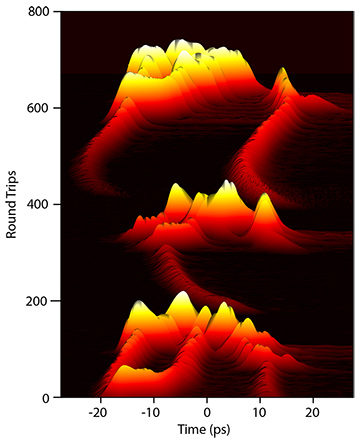 Real-time experimental measurements of the chaotic growth, decay and collision behavior of the temporal intensity of picosecond solitons inside an optical fiber laser. The results show the evolution over 800 round trips during the laser start-up phase. An accompanying video shows a fly-through of this figure, zooming in on certain aspects of the evolution. [Enlarge figure]
Real-time experimental measurements of the chaotic growth, decay and collision behavior of the temporal intensity of picosecond solitons inside an optical fiber laser. The results show the evolution over 800 round trips during the laser start-up phase. An accompanying video shows a fly-through of this figure, zooming in on certain aspects of the evolution. [Enlarge figure]
Lasers that emit ultrashort light pulses have found wide use in medicine, communications and industrial processing, as well as in fundamental research. Ubiquitous as these sources are, however, the way that the laser pulses actually build up from noise—how a pulse is born—has remained an open question. That’s because real-time measurement techniques for sub-picosecond pulses have not been available at the repetition rates at which these lasers typically operate.
We have recently developed an approach to pulse measurement that solves this long-standing challenge. Our method yields complete characterization of ultrashort pulses in real time, allowing us to study laser start-up in detail. We can follow the transient evolution of ultrashort laser pulses as they emerge from noise, showing how the pulses pass through a complex dynamical regime of chaos before stabilizing into an ultra-precise pulse train.1,2
Our technique exploits the powerful analogy between wave propagation in space and time that rests on the mathematical equivalence of diffraction and dispersion. Exploiting this analogy has led to new methods for real-time spectral measurement through the dispersive Fourier transform3 and real-time temporal magnification using a time lens.4
We have combined these two techniques to yield simultaneous real-time measurement of the optical spectrum and the temporal intensity, at sub-nanometer and sub-picosecond resolutions. The great advantage of recording spectral and temporal properties simultaneously is that phase retrieval can yield the full characteristics of the light field, offering a complete portrait of the laser turn-on dynamics.
Our experiments characterized a passively mode-locked fiber laser, a system emitting “dissipative solitons”—pulses that circulate in the laser because of a delicate double balance of nonlinearity by dispersion, and cavity loss by gain. Dissipative solitons are a central concept in nonlinear science impacting on many other fields such as biology and medicine, and fiber lasers provide a particularly convenient platform for studying their properties.
After the laser was switched on, we were able to measure how pulses developed. Background noise first formed picosecond solitons, which then would break up chaotically into pairs or even triplets before decaying. This process of growth and decay repeated itself until the oscillations were eventually damped, and the laser emerged from chaos into stability.
These results provide, in our view, a new window into the physics of ultrashort-pulse laser dynamics. We anticipate wide application of our real-time technique in source optimization as well as in more fundamental studies of instabilities such as optical rogue waves.
Researchers
P. Ryczkowski, M. Närhi and G. Genty, Tampere University of Technology, Tampere, Finland
C. Billet, J.-M. Merolla and J.M. Dudley, CNRS–Université Bourgogne Franche-Comté, Besançon, France
References
1. P. Ryczkowski et al. CLEO, OSA Technical Digest paper AF2Q.1 (2018).
2. P. Ryczkowski et al. Nat. Photon. 12, 221 (2018).
3. K. Goda and B. Jalali. Nat. Photon. 7, 102 (2013).
4. R. Salem et al. Adv. Opt. Photon. 5, 274 (2013).

